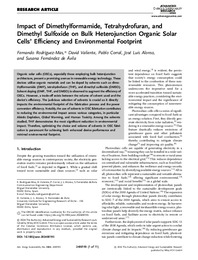Por favor, use este identificador para citar o enlazar este ítem:
https://hdl.handle.net/11000/35077Registro completo de metadatos
| Campo DC | Valor | Lengua/Idioma |
|---|---|---|
| dc.contributor.author | Corral González, Pablo | - |
| dc.contributor.author | Rodríguez-Mas, Fernando | - |
| dc.contributor.author | Valiente, David | - |
| dc.contributor.author | Alonso, José Luis | - |
| dc.contributor.author | Fernandez de Avila, Susana | - |
| dc.contributor.other | Departamentos de la UMH::Ingeniería de Comunicaciones | es_ES |
| dc.date.accessioned | 2025-01-21T09:31:11Z | - |
| dc.date.available | 2025-01-21T09:31:11Z | - |
| dc.date.created | 2024 | - |
| dc.identifier.citation | Advanced Energy & Sustainability Research | es_ES |
| dc.identifier.issn | 2699-9412 | - |
| dc.identifier.uri | https://hdl.handle.net/11000/35077 | - |
| dc.description.abstract | Organic solar cells (OSCs), especially those employing bulk heterojunction architecture, present a promising avenue in renewable energy technology. These devices utilize organic materials and can be doped by solvents such as dimethylformamide (DMF), tetrahydrofuran (THF), and dimethyl sulfoxide (DMSO). Solvent doping (DMF, THF, and DMSO) is observed to augment the efficiency of OSCs. However, a trade-off exists between the volume of solvent used and the device's efficiency. The judicious selection of solvents is crucial as it directly impacts the environmental footprint of the fabrication process and the power conversion efficiency. Notably, the use of solvents in OSC fabrication contributes to reducing the environmental impact across various categories, in particular Abiotic Depletion, Global Warming, and Human Toxicity. Among the solvents studied, THF demonstrates the most significant reduction in environmental impact. Therefore, optimizing the choice and volume of solvents in OSC fabrication is paramount for achieving both enhanced device performance and minimal environmental footprint. | es_ES |
| dc.format | application/pdf | es_ES |
| dc.format.extent | 11 | es_ES |
| dc.language.iso | eng | es_ES |
| dc.publisher | Wiley | es_ES |
| dc.relation.ispartofseries | 5 | es_ES |
| dc.relation.ispartofseries | 10 | es_ES |
| dc.rights | info:eu-repo/semantics/openAccess | es_ES |
| dc.rights | Attribution-NonCommercial-NoDerivatives 4.0 Internacional | * |
| dc.rights.uri | http://creativecommons.org/licenses/by-nc-nd/4.0/ | * |
| dc.subject.other | CDU::6 - Ciencias aplicadas::62 - Ingeniería. Tecnología | es_ES |
| dc.title | Impact of Dimethylformamide, Tetrahydrofuran, and Dimethyl Sulfoxide on Bulk Heterojunction Organic Solar Cells’ Efficiency and Environmental Footprint | es_ES |
| dc.type | info:eu-repo/semantics/article | es_ES |
| dc.relation.publisherversion | https://doi.org/10.1002/aesr.202400193 | es_ES |

Ver/Abrir:
Adv Energy and Sustain Res - 2024 - Rodríguez‐Mas - Impact of Dimethylformamide Tetrahydrofuran and Dimethyl Sulfoxide on.pdf
1,74 MB
Adobe PDF
Compartir:
 La licencia se describe como: Atribución-NonComercial-NoDerivada 4.0 Internacional.
La licencia se describe como: Atribución-NonComercial-NoDerivada 4.0 Internacional.
.png)